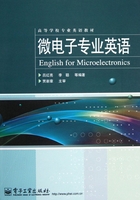
3.3 Effective Mass Theory
The problem of describing the motion of an electron through a semiconductor seems at first to be an enormous task given the high density of atoms in a solid and the apparently numerous opportunities for collisions and deflections. The highly ordered,periodic nature of the crystal lattice simplifies the problem tremendously,however. In particular,we find that if the crystal is perfect and infinite with all of the atoms fixed in their proper positions,then the conduction electrons can be modeled as particles that move through the lattice without suffering any collisions or deflections. They move essentially as though they were traveling in free space. The only difference is that rather than accelerating in response to external forces as though they had the free space electron mass,the electrons respond as if they had a different mass. This mass,which we call the electron effective mass m *e,is usually less than the free electron mass,and contains all of the effects of the perfect crystal lattice on the carrier motion.
The model that yields this result is called the effective mass model,and it is the theoretical basis for all of our intuitive pictures of electrons and holes in semiconductors. In the case of electrons,the effective mass model tells us,as we have just said,that we can model conduction electrons in a semiconductor as particles in free space with a mass m*e and a net charge q. We call these new particles electrons also,but we must be careful to remember that they are not really electrons but rather are some sort of quasiparticle that looks and behaves much like an electron.
In the effective mass picture,defects in the perfect lattice structure introduce objects in the path of the electrons with which they can collide. For example,an impurity atom occupying the site in a silicon crystal that would normally be occupied by a silicon atom would be modeled as a sphere fixed in free space. An electron traveling through the crystal can collide with or be deflected by this object. This idea is illustrated in Fig.3.1.
The concept of a hole is another very important result of the effective mass model. According to this model,an unoccupied state in the valence band(i. e.,an unoccupied covalent bond in the lattice)can also be modeled as a particle traveling in free space. This particle has a positive mass,now called the hole effective mass m *h,and it has a positive charge +q. As was the case with electrons,holes,too,can collide with and be deflected by defects in the crystal.
The vibrations of the lattice atoms about their equilibrium positions,which are always happening at finite temperature,are also “defects” in the perfectly periodic lattice,and they can also deflect or scatter electrons and holes moving through a crystal. These lattice vibrations can themselves be modeled as objects,called phonons,with which the charge carriers interact(i. e.,collide and scatter). The number of phonons increases as the temperature increases,so the holes and electrons suffer more collisions with phonons at higher temperatures. This leads to a decrease in the mobility of the carriers at higher temperatures,as we discussed in Session 5.
In summary,the effective mass model is one of the most amazing results of solid-state physics,but we seldom even think about it in most of our dealings with semiconductors and devices. That conduction electrons and mobile holes exist in a semiconductor is just taken for granted,and yet holes and electrons are also models. It is perhaps a testimonial to the importance of the effective mass model that we rarely even question the appropriateness of using it in our dealings with semiconductors and device structures. It is unlikely that you can fully appreciate this at this stage in your career,but the more you learn about solid-state physics and semiconductor devices,the more you will be impressed by the ubiquitousness of this model and the amazing breadth of structures and situations in which it is useful.

Fig.3.1 Two possible pictures of an electron moving through a crystal lattice:(a)the classical picture of a conventional electron in a periodic grid of obstacles(the lattice atoms)containing an occasional additional obstacle(defects);(b)the effective mass picture of an electron with a different mass,m*e,moving in free space and encountering occasional obstacles.